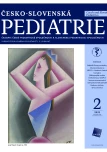Hybrid imaging PET/MRI in pediatric patients
Authors:
Ferda Jiří 1; Ferdová Eva 1; Tůma Vojtěch 1; Bosman Roman 2; Votava Tomáš 3
Authors‘ workplace:
Klinika zobrazovacích metod, Fakultní nemocnice Plzeň, Lékařská fakulta Univerzity Karlovy v Plzni
1; Klinika anesteziologie, resuscitace a intenzivní medicíny, Fakultní nemocnice Plzeň, Lékařská fakulta Univerzity Karlovy v Plzni
2; Dětská klinika, Fakultní nemocnice Plzeň, Lékařská fakulta Univerzity Karlovy v Plzni
3
Published in:
Čes-slov Pediat 2023; 78 (2): 65-73.
Category:
Review
doi:
https://doi.org/10.55095/CSPediatrie2023/010
Overview
Manuscript reviews general information about use of hybrid imaging using positron emission tomography and magnetic resonance imaging in pediatric patients. The basic technical aspects, logistic and specific aspects in children are explained. There are summarized the most serious indications of PET/MRI in children when this kind of imaging might play the important role.
Keywords:
Positron emission tomography – PET/MRI – pediatric imaging – hybrid imaging
Sources
1. Gatidis S, Bender B, Reimold M, Schäfer JF. PET/MRI in children. Eur J Radiol 2017; 94: A64–A70.
2. Sepehrizadeh T, Jong I, DeVeer M, Malhotra A. PET/MRI in paediatric disease. Eur J Radiol. 2021; 144: 109987. doi: 10.1016/j.ejrad.2021.109987
3. Gatidis S, Schmidt H, la Fougère C, et al. Defining optimal tracer activities in pediatric oncologic whole-body 18F-FDG-PET/MRI. Eur J Nucl Med Mol Imaging 2016; 43(13): 2283–2289.
4. Kirchner J, Deuschl C, Schweiger B, et al. Imaging children suffering from lymphoma: an evaluation of different 18F-FDG PET/MRI protocols compared to whole-body DW-MRI. Eur J Nucl Med Mol Imaging 2017; 44(10): 1742–1750.
5. Georgi TW, Stoevesandt D, Kurch L, et al. Optimized whole-body positron emission tomography magnetic resonance imaging sequence workflow in pediatric Hodgkin lymphoma patients. J Nucl Med 2022. doi: 10.2967/jnumed. 122.264112
6. Ferdová E, Ferda J, Baxa J. 18F-FDG-PET/MRI in lymphoma patients. Eur J Radiol 2017; 94: A52–A63.
7. Mueller WP, Melzer HI, Schmid I, et al. The diagnostic value of 18F-FDG PET and MRI in paediatric histiocytosis. Eur J Nucl Med Mol Imaging 2013; 40(3): 356–363.
8. Gatidis S, la Fougère C, Schaefer JF. Pediatric oncologic imaging: a key application of combined PET/MRI. Rofo 2016; 188(4): 359–3aa64.
9. Baratto L, Hawk KE, States L, et al. PET/MRI improves management of children with cancer. J Nucl Med 2021; 62(10): 1334–1340.
10. Pfluger T, Melzer HI, Mueller WP, et al. Diagnostic value of combined ¹⁸F- -FDG PET/MRI for staging and restaging in paediatric oncology. Eur J Nucl Med Mol Imaging 2012; 39(11): 1745–1755.
11. Elmanzalawy A, Vali R, Chavhan GB, et al. The impact of 18F-FDG PET on initial staging and therapy planning of pediatric soft-tissue sarcoma patients. Pediatr Radiol 2020; 50(2): 252–260.
12. Jissendi-Tchofo P, Pandit F, Vallée L, et al. Brain regional glucose uptake changes in isolated cerebellar cortical dysplasia: qualitative assessment using coregistrated FDG-PET/MRI. Cerebellum 2012; 11(1): 280–288.
13. Salamon N, Kung J, Shaw SJ, et al. FDG-PET/MRI coregistration improves detection of cortical dysplasia in patients with epilepsy. Neurology 2008; 71(20): 1594–1601.
Labels
Neonatology Paediatrics General practitioner for children and adolescentsArticle was published in
Czech-Slovak Pediatrics

2023 Issue 2
Most read in this issue
- Myocarditis and cardiomyopathy
- Preparation of the child for the magnetic resonance examination
- Current pharmacotherapy options in pediatric obesity
- Severe combined immunodeficiencies
